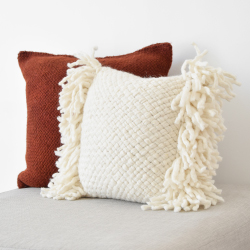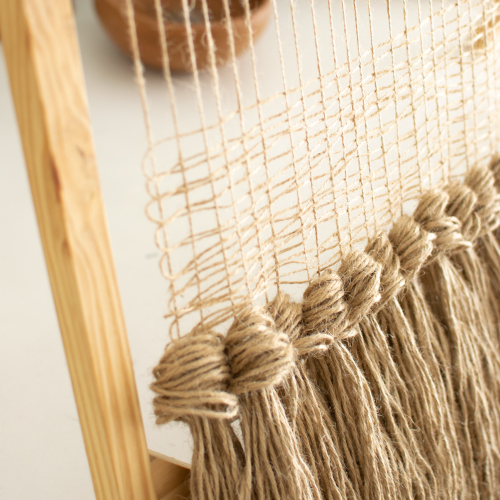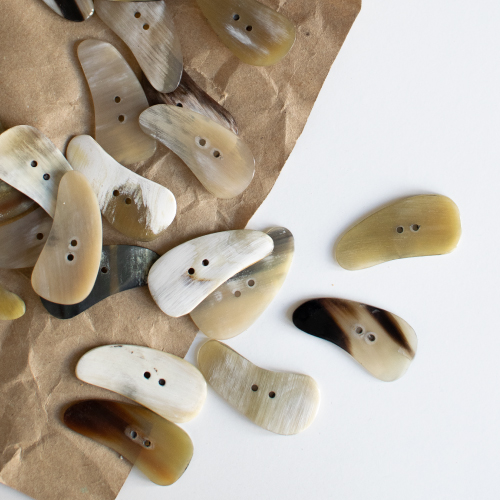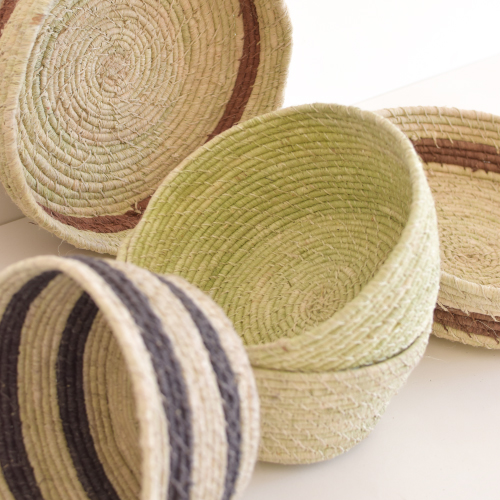Producto Argentino | Argentine Product
Inspirados en nuestro país, la Argentina, ofrecemos distintos productos significativos de su identidad; ya sea por los materiales autóctonos con los que están realizados, por las técnicas que fueron empleadas o por las costumbres que simbolizan.
Todos nuestros productos significan de cierta manera un aspecto de nuestro tan rico país. A lo largo y a lo ancho del territorio argentino, encontramos una infinidad de materias primas, de artesanos, oficios y culturas que marcaron nuestra historia y que es nuestro compromiso que aún hoy escriban nuestro presente.
Materiales como cuero, lana, algodón y madera. Oficios como la marroquinería, soguería, tejeduría y telar, así como costumbres y personajes como el mate, el gaucho y el caballo, todos ellos entre otros tantos, son protagonistas e inspiración de nuestra marca.
-
Inspired by our country, Argentina, we offer various products that embody its identity; whether through the native materials they are made from, the techniques employed, or the customs they symbolize.
Each of our products represents in some way an aspect of our rich country. Across the Argentine territory, we find a wealth of raw materials, artisans, crafts, and cultures that have shaped our history, and it is our commitment to ensure they continue to shape our present.
Materials such as leather, wool, cotton, and wood. Crafts such as leatherworking, braiding, weaving, and loom work, as well as customs and figures such as mate (traditional drink), the gaucho (cowboy), and the horse, among many others, are protagonists and the inspiration behind our brand.

Cuero
Argentina es conocida mundialmente por la calidad distintiva de su cuero. Un material noble, perdurable y con infinidad de usos. Las curtiembres en Argentina tienen una larga historia y tradición.
El cuero vacuno se obtiene como subproducto de la cría de ganado, una actividad por excelencia de nuestro país que ocupa una gran superficie.
-
Leather
Argentina is globally renowned for the distinctive quality of its leather. A noble material, durable and with countless uses. Tanneries in Argentina have a long history and tradition.
Beef leather is obtained as a byproduct of cattle farming, a quintessential activity in our country that occupies a vast area.

Soguería Criolla
La soguería criolla también es otro sello distintivo de nuestro país. Es un oficio artesanal y tradicional en la cultura rural, que se transmite de generación en generación.
A diferencia de la talabartería, que trabaja con cuero curtido, la materia prima en la soguería es el cuero crudo.
El cuero crudo es el cuero en su estado natural, totalmente ecológico, sin componentes que alteren su naturaleza. Tiene el color natural del animal, con todas las características de su piel.
La soguería es un proceso lento y trabajoso, y cada paso es fundamental para lograr un producto de alta calidad.
-
Soguería Criolla
Another distinctive hallmark of our country. It's a traditional and artisanal craft within rural culture, passed down from generation to generation.
Unlike leatherworking, which uses tanned leather, the raw material in this technique is rawhide.
Rawhide is leather in its natural state, completely ecological, without components that alter its nature. It retains the natural color of the animal, with all the characteristics of its skin.
This is a slow and laborious process, where each step is crucial to achieving a high-quality product.


Lana
La lana es otra de las materias primas destacadas de la Argentina. Una fibra natural que se obtiene de los animales a través de un proceso que se denomina "esquila". Las fibras naturales se caracterizan por respirar naturalmente, cualidad que genera que las mismas sirvan de aislantes térmicos. Además son resistentes y duraderas.
La Patagonia es la región en donde se concentra la mayor población ovina y la producción de lana es parte de la esencia del sur Argentino.
La gran variedad de climas que posee nuestro territorio nacional permiten producir todas las clases de lana ovina, desde la más fina –Merino- hasta la más gruesa –Lincoln y Criolla-.
En el extremo opuesto, el Norte Argentino se destaca por la producción de lana de llama. En Argentina contamos con un genotipo especial que se denomina llama antofalla o llama argentina, que se diferencia del resto de sus vecinas, por tener una fibra más fina y suave. Es una fibra natural muy ligera, sedosa y capaz de regular la temperatura corporal. Tiene mayor capacidad térmica que la lana de oveja.
-
Wool
Wool is another prominent raw material from Argentina. It's a natural fiber obtained from animals through a process called "shearing". Natural fibers are known for their breathability, which makes them excellent thermal insulators. They are also resilient and long-lasting.
Patagonia is the region with the highest concentration of sheep and wool production is a cornerstone of southern Argentina.
The diverse climates across our national territory allow us to produce all types of sheep's wool, from the finest Merino to the coarser Lincoln and Criolla varieties.
Conversely, northern Argentina is known for llama wool production. Argentina boasts a special genotype known as Antofalla llama or Argentine llama, which differs from its neighbors due to its finer and softer fiber. It's a very lightweight, silky natural fiber capable of regulating body temperature, with greater thermal capacity than sheep's wool.
Cardón
Forma parte del paisaje emblemático del Norte Argentino y tiene un importante rol en la cultura de la región.
Muchas leyendas y creencias populares hablan del origen de las inmensas colonias de cardones que se hallan a lo largo de todo el Norte argentino.
Una de estas leyendas cuenta que los cardones que hay en los valles, en especial en Amaicha del Valle, son indios, que convertidos en plantas, aún vigilan los valles y los cerros. Ellos velan por la felicidad de sus habitantes que, de esta manera, nunca más serán perturbados por extraños en conquista de tierras.
Su utilidad como madera es múltiple, pero sólo se la utiliza de los cardones que se encuentran muertos y/o secos. Cortarlos verdes es un delito que está penado legalmente.
Es por este motivo que las artesanías en madera de cardón son de producción muy limitada y adquieren un valor muy preciado.
-
Cardón wood
It is part of the emblematic landscape of Northern Argentina and plays an important role in the region's culture.
Many legends and popular beliefs talk about the origin of the immense colonies of cacti found throughout Northern Argentina. One of these legends tells that the cacti in the valleys, especially in Amaicha del Valle, are Indians who, transformed into plants, still watch over the valleys and hills. They ensure the happiness of their inhabitants, who, in this way, will never again be disturbed by strangers in search of land.
Their utility as wood is multiple, but it is only used from cacti that are found dead and/or dry. Cutting them green is a crime punishable by law. For this reason, handicrafts made of cactus wood are of very limited production and acquire a very precious value.


Telar
Esta técnica ancestral es utilizada para realizar distintos tejidos. Hoy en día es preservada por distintas comunidades argentinas que generación tras generación van plasmando su conocimiento, historia y cultura en cada una de las piezas que realizan.
Se utilizan distintas fibras naturales como lana, algodón y chaguar. Todas extraídas de las mismas comunidades e hiladas y teñidas de forma artesanal con tintes provenientes de la naturaleza como raíces, cortezas, hojas y flores.
Hay distintos tipos y técnicas de telar, y cada una de ellas así como los objetos que dan origen, simbolizan y representan historias, culturas, arte y lenguaje.
-
Loom
This ancestral technique is used to create various textiles.
Today, it is preserved by different Argentine communities, who, generation after generation, embed their knowledge, history, and culture into each piece they make.
Various natural fibers such as wool, cotton, and chaguar are used. All of these are sourced from the same communities and spun and dyed by hand with natural dyes derived from roots, bark, leaves, and flowers. There are different types and techniques of loom, and each one, as well as the objects they produce, symbolize and represent stories, cultures, art, and language.
Cestería
Este proceso de confección con fibras vegetales se remonta a la antiguedad y en la actualidad se mantiene vivo en numerosos puntos de nuestro país de la mano de comunidades Qom, Wichi y Pilagá entre otras.
Principalmente son mujeres artesanas las que se dedican a este oficio, que con su paciencia recolectan las fibras que se extraen de distintas plantas, les dan el tratamiento necesario y luego las convierten en obras de arte a través del entretejido con sus manos, un proceso lento y laborioso que plasma su historia y si identidad cultural.
-
Basketry
This process of crafting with plant fibers dates back to ancient times and is still alive today in many parts of our country, thanks to the efforts of Qom, Wichi, and Pilagá communities, among others.
It is mainly women artisans who dedicate themselves to this craft. With patience, they collect fibers from various plants, treat them as needed, and then transform them into works of art through hand weaving—a slow and laborious process that reflects their history and cultural identity.



